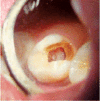Comparative evaluation of Ferric Sulfate, Electrosurgical and Diode Laser on human primary molars pulpotomy: an "in-vivo" study
- PMID: 24771970
- PMCID: PMC3999430
- DOI: 10.5978/islsm.14-OR-05
Comparative evaluation of Ferric Sulfate, Electrosurgical and Diode Laser on human primary molars pulpotomy: an "in-vivo" study
Abstract
Background and aims: Despite modern advances in the prevention of dental caries and increased understanding of the importance of maintaining the natural primary dentition, many teeth are still lost prematurely. This can lead to malocclusion with aesthetic, phonetic and functional problems that may be transient or permanent. Therefore, maintaining the integrity and health of the oral tissues is the primary objective of pulp treatment. Pulpotomy has remained an acceptable and mainstay treatment in preserving the vitality of primary tooth and prolonging its life till the permanent successor erupts. Various materials and techniques are available for pulpotomy on primary molars; all with some advantages and disadvantages. The present study was carried out on 45 primary molars to evaluate and compare the clinical and radiographic success of diode laser, electrosurgical and ferric sulfate pulpotomy over a period of 9 months. Materials (Subjects) and Methods: The forty five primary molars were randomly and equally divided into three treatment groups which were as follows: Group A: 15 primary molars treated with 15.5% Ferric sulfate Group B: 15 primary molars treated with electrosurgical unit and Group C: 15 primary molars treated with diode laser. All teeth in three categories were followed up clinically and radiographically at 1, 3, 6 and 9 months post treatment and the findings were recorded on the prepared proforma
Results: Clinically, 86.6% success rate was found in ferric sulfate group whereas 100% success rate was found in electrosurgical and diode laser groups. Radiographically, 80% success rate was found in all the three groups at the end of 9 months with internal resorption being the most common cause of failure after pulpotomy.
Conclusions: Thus, electrosurgery and diode lasers appear to be acceptable alternative to pharmacotherapeutic pulpotomy agents.
Keywords: Diode Laser; Electrosurgery; Ferric Sulfate; Pulpotomy.
Figures





References
-
- Ranly DM. (1994). Pulpotomy therapy in primary teeth: new modalities for old rationales. Pediatr Dent, 16:403-9 - PubMed
-
- Fuks AB. (2000). Pulp therapy for the primary and young permanent dentitions. Dent Clin North Am, 44:571-96 - PubMed
-
- Fishman SA, Udin RD, Good DL, Rodef F.(1996). Success of electrofulguration pulpotomies covered by zinc oxide and eugenol or calcium hydroxide: a clinical study. Pediatr Dent, 18:385-90 - PubMed
-
- Fei AL, Udin RD, Johnson R. (1991). A clinical study of ferric sulfate as a pulpotomy agent in primary teeth. Pediatr Dent, 13:327-32 - PubMed
LinkOut - more resources
Full Text Sources
Other Literature Sources
